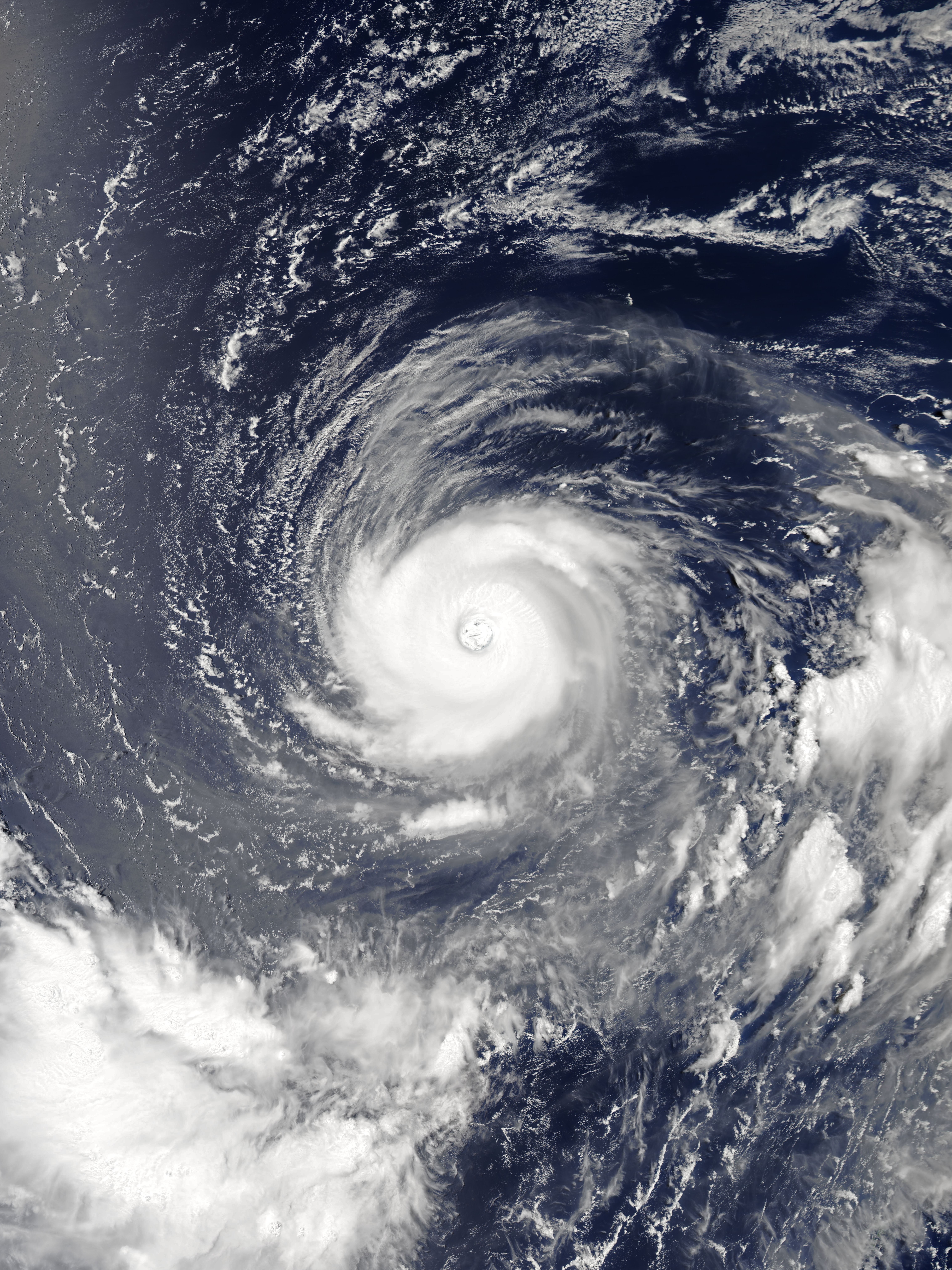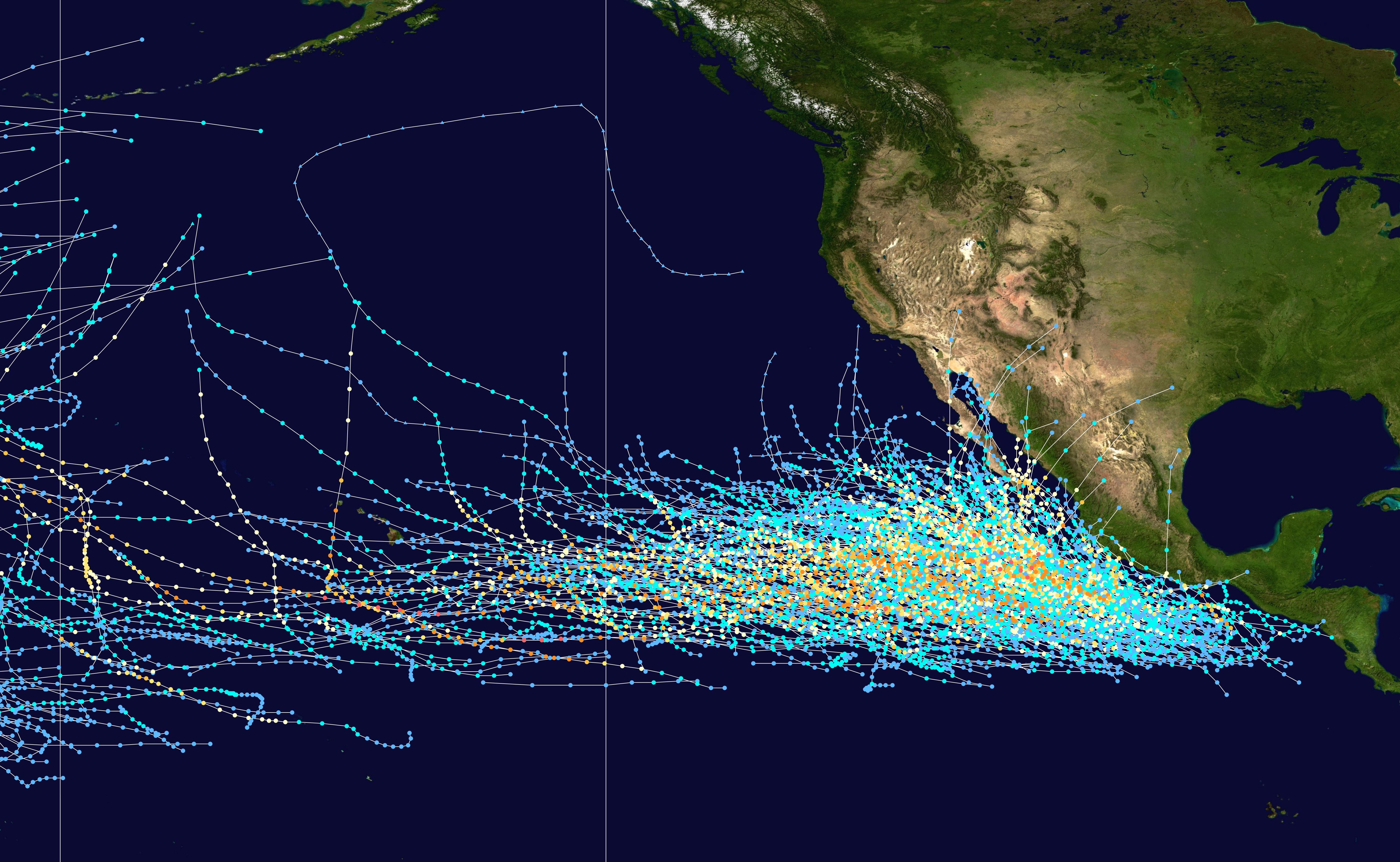|
Outline Of Tropical Cyclones
The following outline is provided as an overview of and topical guide to tropical cyclones: Tropical cyclone – storm characterized by a large low-pressure center and numerous thunderstorms that produces strong winds and heavy rain. Tropical cyclones develop or strengthen when water evaporated from the ocean is released as the saturated air rises, resulting in condensation of water vapor contained in the moist air. They are fueled by a different heat mechanism than other cyclonic windstorms such as nor'easters, European windstorms, and polar lows. The characteristic that separates tropical cyclones from other cyclonic systems is that at any height in the atmosphere, the center of a tropical cyclone will be warmer than its surroundings; a phenomenon called " warm core" storm systems. Nature of tropical cyclones Tropical cyclones can be described as all of the following: * Storm – disturbed state of an environment or astronomical body's atmosphere especially affect ... [...More Info...] [...Related Items...] OR: [Wikipedia] [Google] [Baidu] |
East Pacific Tc Climatology
East is one of the four cardinal directions or points of the compass. It is the opposite direction from west and is the direction from which the Sun rises on the Earth. Etymology As in other languages, the word is formed from the fact that east is the direction where the Sun rises: ''east'' comes from Middle English ''est'', from Old English ''ēast'', which itself comes from the Proto-Germanic *''aus-to-'' or *''austra-'' "east, toward the sunrise", from Proto-Indo-European *aus- "to shine," or "dawn", cognate with Old High German ''*ōstar'' "to the east", Latin ''aurora'' 'dawn', and Greek ''ēōs'' 'dawn, east'. Examples of the same formation in other languages include Latin oriens 'east, sunrise' from orior 'to rise, to originate', Greek ανατολή anatolé 'east' from ἀνατέλλω 'to rise' and Hebrew מִזְרָח mizraḥ 'east' from זָרַח zaraḥ 'to rise, to shine'. ''Ēostre'', a Germanic goddess of dawn, might have been a personification of both da ... [...More Info...] [...Related Items...] OR: [Wikipedia] [Google] [Baidu] |
Hurricane Dorian
Hurricane Dorian was an extremely powerful and catastrophic tropical cyclone, which became the most intense on record to strike The Bahamas. It is tied with the 1935 Labor Day hurricane for the strongest landfall in the Atlantic basin in terms of maximum sustained winds. It is regarded as the worst natural disaster in The Bahamas' recorded history. With winds peaking at , it was also one of the most powerful hurricanes recorded in the Atlantic Ocean in terms of Maximum sustained wind, 1-minute sustained winds, and the strongest since Hurricane Wilma, Wilma in 2005 Atlantic hurricane season, 2005. Dorian was the fourth named storm, second hurricane, the first major hurricane, and the first Category 5 hurricane of the 2019 Atlantic hurricane season. Dorian struck the Abaco Islands on September 1 with maximum sustained winds of 185 mph (295 km/h), tying with the 1935 Labor Day hurricane for the highest wind speeds of an Atlantic hurricane ever recorded at landfall. ... [...More Info...] [...Related Items...] OR: [Wikipedia] [Google] [Baidu] |
Hurricane Isabel
Hurricane Isabel was a Category 5 Atlantic hurricane that struck the east coast of the United States in September 2003. The ninth named storm, fifth hurricane, and second major hurricane of the season, Isabel formed in the eastern Atlantic Ocean on September 6 from a tropical wave. It moved northwestward through an area with light wind shear and warm waters, resulting in strengthening. Isabel reached peak winds of on September 11. After fluctuating in intensity for four days, Isabel gradually weakened and made landfall on the Outer Banks of North Carolina, with winds of on September 18, or a Category 2 on the Saffir-Simpson scale. Isabel quickly weakened over land and became extratropical over western Pennsylvania on the next day. On September 20, the extratropical remnants of Isabel were absorbed into another system over Eastern Canada. In North Carolina, the storm surge from Isabel washed out a portion of Hatteras Island to form what was unofficially known ... [...More Info...] [...Related Items...] OR: [Wikipedia] [Google] [Baidu] |
Hurricane Ivan
Hurricane Ivan was a large, long-lived, and devastating tropical cyclone that caused widespread damage in the Caribbean and United States. The ninth named storm, the sixth hurricane, and the fourth major hurricane of the active 2004 Atlantic hurricane season, Ivan formed in early September and reached Category 5 strength on the Saffir–Simpson Hurricane Scale (SSHS). Ivan caused catastrophic damage in Grenada as a strong Category 3 storm, heavy damage in Jamaica as a strong Category 4 storm, and then severe damage in Grand Cayman, Cayman Islands, and the western tip of Cuba as a Category 5 hurricane. After peaking in strength, the hurricane moved north-northwest across the Gulf of Mexico to strike Pensacola/Milton, Florida and Alabama as a strong Category 3 storm, causing significant damage. Ivan dropped heavy rain on the Southeastern United States as it progressed northeastward and eastward through the Eastern United States, becoming an extratropical cyclone on September 1 ... [...More Info...] [...Related Items...] OR: [Wikipedia] [Google] [Baidu] |
Cape Verde Hurricane
A Cape Verde hurricane or Cabo Verde hurricane is an Atlantic hurricane that originates at low-latitude in the tropical Atlantic from a tropical wave that has passed over or near the Cape Verde islands after exiting the coast of West Africa. The average Atlantic hurricane season has about two Cape Verde hurricanes, which are often the largest and most intense storms of the season due to having plenty of warm open ocean over which to develop before encountering land or other factors prompting weakening. A good portion of Cape Verde storms are large, and some, such as hurricanes Allen, Ivan, Dean, and Irma have set various records. Most of the longest-lived tropical cyclones in the Atlantic basin are Cape Verde hurricanes. While many move harmlessly out to sea, some move across the Caribbean Sea and into the Gulf of Mexico, becoming damaging storms for Caribbean nations, Central America, Mexico, Bermuda, the United States, and occasionally even Canada. Research projects since t ... [...More Info...] [...Related Items...] OR: [Wikipedia] [Google] [Baidu] |
Mediterranean Tropical-like Cyclone
Mediterranean tropical-like cyclones, often referred to as Mediterranean cyclones or Mediterranean hurricanes, and shortened as medicanes, are meteorological phenomena occasionally observed over the Mediterranean Sea. On a few rare occasions, some storms have been observed reaching the strength of a Saffir–Simpson scale#Category 1, Category 1 hurricane on the Saffir–Simpson scale, and Medicane Ianos in 2020 was recorded reaching Saffir–Simpson scale#Category 2, Category 2 intensity. The main societal hazard posed by medicanes is not usually from destructive winds, but through life-threatening torrential rains and flash floods. The occurrence of medicanes has been described as not particularly rare. Tropical-like systems were first identified in the Mediterranean basin in the 1980s, when widespread weather satellite, satellite coverage showing tropical-looking low pressures which formed a eye (cyclone), cyclonic eye in the center were identified. Due to the dry nature of the ... [...More Info...] [...Related Items...] OR: [Wikipedia] [Google] [Baidu] |
Japan Meteorological Agency
The Japan Meteorological Agency (JMA; ''気象庁, Kishō-chō'') is a division of the Ministry of Land, Infrastructure, Transport and Tourism dedicated to the Scientific, scientific observation and research of natural phenomena. Headquartered in Minato, Tokyo the government agency, agency collects data on meteorology, hydrology, seismology, volcanology, and other related fields. The JMA is responsible for collecting and disseminating weather data and Forecasting, forecasts to the public, as well as providing specialized information for aviation and Marine weather forecasting, marine sectors. Additionally, the JMA issues warnings for volcanic eruptions and is integral to the nationwide Earthquake Early Warning (Japan), Earthquake Early Warning (EEW) system. As one of the Regional Specialized Meteorological Centers designated by the World Meteorological Organization (WMO), the JMA also Forecasting, forecasts, Tropical cyclone naming, names, and distributes warnings for tropical ... [...More Info...] [...Related Items...] OR: [Wikipedia] [Google] [Baidu] |
Typhoon
A typhoon is a tropical cyclone that develops between 180° and 100°E in the Northern Hemisphere and which produces sustained hurricane-force winds of at least . This region is referred to as the Northwestern Pacific Basin, accounting for almost one third of the world's tropical cyclones. For organizational purposes, the northern Pacific Ocean is divided into three regions: the eastern (North America to 140°W), central (140°W to 180°), and western (180° to 100°E). The Regional Specialized Meteorological Center (RSMC) for tropical cyclone forecasts is in Japan, with other tropical cyclone warning centres for the northwest Pacific in Hawaii (the Joint Typhoon Warning Center), the Philippines, and Hong Kong. Although the RSMC names each system, the main name list itself is coordinated among 18 countries that have territories threatened by typhoons each year. Within most of the northwestern Pacific, there are no official typhoon seasons as tropical cyclones form througho ... [...More Info...] [...Related Items...] OR: [Wikipedia] [Google] [Baidu] |
Atlantic Hurricane
An Atlantic hurricane is a type of tropical cyclone that forms in the Atlantic Ocean primarily between June and November. The terms "hurricane", "typhoon", and "cyclone, tropical cyclone" can be used interchangeably to describe this weather phenomenon. These storms are continuously rotating around a low pressure center, which causes stormy weather across a large area, which is not limited to just the eye of the storm. They are organized systems of clouds and thunderstorms that originate over tropical or subtropical waters and have closed low-level circulation, and should not be confused with tornadoes, which are another type of cyclone. In the North Atlantic and the Eastern Pacific, the term hurricane is used, whereas ''typhoon'' is used in the Western Pacific near Asia. The more general term ''cyclone'' is used in the rest of the ocean basins, namely the South Pacific and Indian Ocean. Tropical cyclones can be categorized by intensity. ''Tropical storms'' have one-minute maxi ... [...More Info...] [...Related Items...] OR: [Wikipedia] [Google] [Baidu] |
Pacific Hurricane
A Pacific hurricane is a tropical cyclone that develops within the northeastern and central Pacific Ocean to the east of 180°W, north of the equator. For tropical cyclone warning purposes, the northern Pacific is divided into three regions: the eastern (North America to 140°W), central (140°W to 180°), and western (180° to 100°E), while the southern Pacific is divided into 2 sections, the Australian region (90°E to 160°E) and the southern Pacific basin between 160°E and 120°W. Identical phenomena in the western north Pacific are called typhoons. This separation between the two basins has a practical convenience, however, as tropical cyclones rarely form in the central north Pacific due to high vertical wind shear, and few cross the dateline. List of seasons 1950s 1960s 1970s 1980s 1990s 2000s 2010s 2020s History Documentation of Pacific hurricanes dates to the Spanish colonization of Mexico, when the military and missions wrote about "tempesta ... [...More Info...] [...Related Items...] OR: [Wikipedia] [Google] [Baidu] |
Post-tropical Cyclone
A post-tropical cyclone is a former tropical cyclone that no longer possesses enough tropical qualities to be considered a tropical cyclone. The word may refer to a former tropical cyclone undergoing extratropical transition or a tropical cyclone degenerating into a remnant low. A tropical cyclone degenerating into a trough or wave, or having its low level circulation dissipate overland, lacks a cyclonic circulation and is referred as remnants instead of a post-tropical cyclone. However, post-tropical cyclones or remnants can continue producing high winds and heavy rains. Classification/Other post-tropical cyclones Classes Two classes of post-tropical cyclones exist * Extratropical cyclone, which is frontal, sometimes still retains winds of hurricane or tropical storm force. Hurricane Paulette (2020) provides a recent example of an extratropical cyclone, in which it no longer has a warm core in higher latitudes when it was over Nova Scotia and all points north in its traject ... [...More Info...] [...Related Items...] OR: [Wikipedia] [Google] [Baidu] |








